Promote Responsible Stewardship of the Commonwealth’s Natural Resources
The major DCNR accomplishments of 2022 to promote responsible stewardship of the commonwealth’s natural resources are listed below.
TreeVitalize Program
The
TreeVitalize program facilitated the planting of 4,446 trees; and 117 communities are currently recognized by the National Arbor Day Foundation as TreeCity USA Communities.
The program and its partners assisted a total of 410 communities with tree planting and maintenance; planning; training; and other parts of holistic community tree programs.
These communities represent more than six million Pennsylvania residents, which is almost half of the population of the state.
The TreeVitalize program received $3.52 million from the legislature though the Keystone Tree Fund.
DCNR hired its first TreeVitalize Chesapeake Bay Regional Specialist who will work with several Chesapeake Bay environmental justice communities on tree-related projects each community is facing.
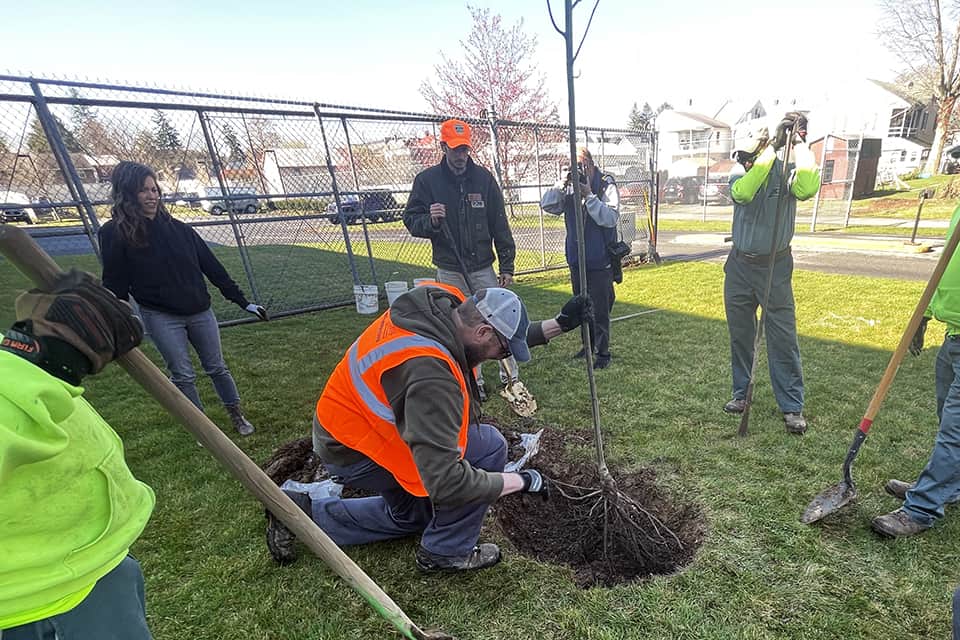
DCNR participates in community tree planting event funded by TreeVitalize in Carlisle in April 2022
Streamside Forest Buffers
The fifth DCNR Watershed Forestry Summit (formerly known as the Riparian Forest Buffer Summit) was held virtually and was attended by approximately 300 professionals.
In 2022, about 226 acres of
riparian forest buffers were planted, comprising approximately 45,316 trees/shrubs. An additional 56 acres of lawn was converted to either meadow or forest in 2022.
In September, DCNR awarded a little more than $1 million in grant investments for planting of an estimated 212 new acres of riparian forest buffers across the commonwealth.
Stream buffers help keep nutrients and sediments from the land from impacting water quality.
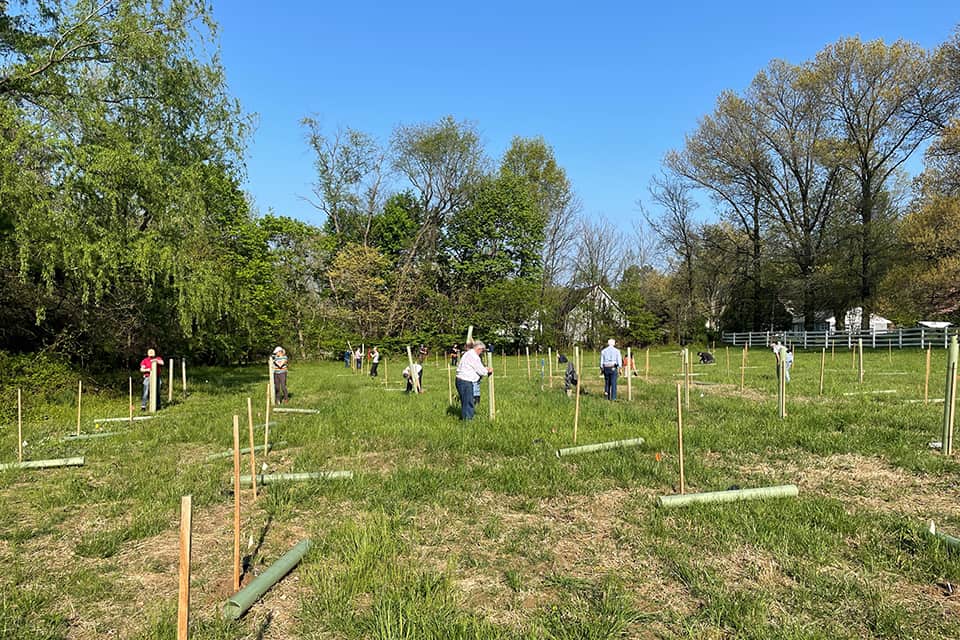
DCNR helps plant a streamside forest buffer along Landis Run in Lancaster in May 2022
Correctional Institution Arboriculture Training Program
DCNR’s Bureau of Forestry continued to partner with the Pennsylvania Department of Corrections for a sixth year in 2022.
To date, the program has reached 150 incarcerated inmates totaling more than 432 hours of training -- at Rockview and Huntingdon state correctional institutions.
The program is designed to provide reentry skills inmates can tap after discharge and grow the number of workers planting and maintaining trees.
In 2022, DCNR staff members instructed students on arboriculture, plant biology, invasive plant management, and the creation of native meadow habitat for wildlife and pollinators.
State Forest Management Agreement
DCNR’s Bureau of Forestry and the U.S. Forest Service signed an Agreement to Advance Shared Stewardship, strengthening their commitment to collaborative land management efforts throughout the commonwealth.
The agreement establishes a framework to work collaboratively on forest management, accomplishing mutual goals, furthering common interests, and effectively responding to the increasing suite of challenges facing the communities, landscapes and natural resources in Pennsylvania.
Bat Habitat Conservation Plan
DCNR and the Pennsylvania Game Commission entered the second year of following the conservation measures outlined in the
State Lands Forestry Habitat Conservation Plan for Indiana bats and northern long-eared bats.
The federal incidental take permit places limits on amount bat habitat affected by forestry activities per year.
DCNR and the Game Commission provided the first annual report in January 2022 and were well below the permitted limit of take for both species:
- The take limit for Indiana bat habitat is 19,770 acres -- only 3,173 acres of covered activities took place within that habitat (16 percent).
- The take limit for northern long-eared bat habitat is 130,386 acres -- only 3,511 acres of covered activities took place within that habitat (3 percent).
Land Conservation
More than 6,000 acres were conserved by DCNR in 2022. All land conservation projects will help with climate resilience and mitigation.
Additions to the Old Growth Forest Network
The Old-Growth Forest Network is a national organization working to preserve ancient forests for the enjoyment of present and future generations.
In counties capable of supporting forest growth, the network identifies at least one forest that will be protected from logging and open to the public. DCNR assisted in adding these five sites in Pennsylvania in 2022:
- Hemlocks Natural Area, Perry County
- Beartown Woods Natural Area, Franklin County
- Sweet Root Natural Area, Bedford County
- Boyd Big Tree Preserve, Dauphin County
- Nolde Forest Environmental Education Center, Berks County
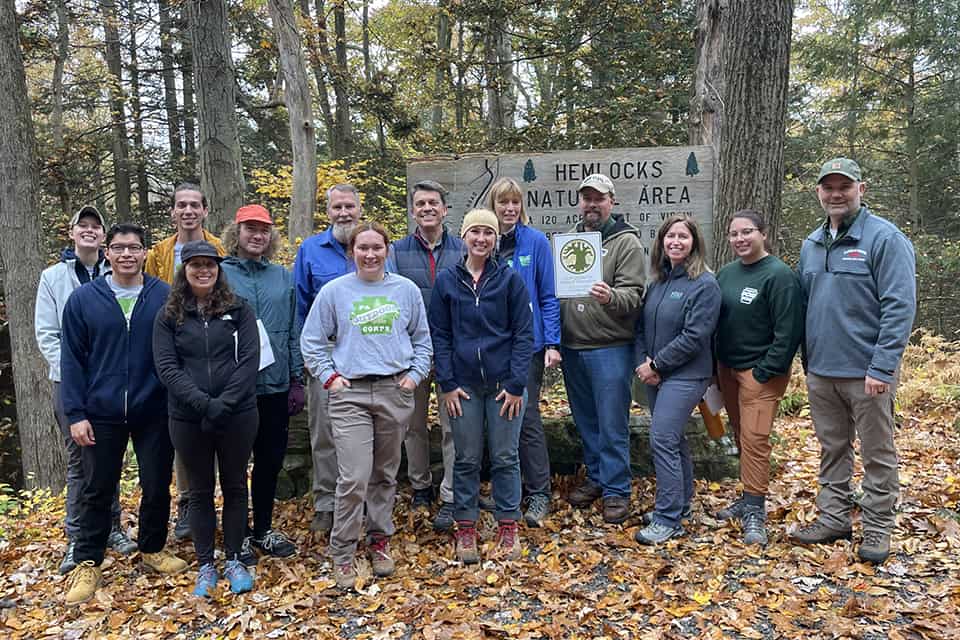
DCNR celebrates the Hemlocks Natural Area being added to Old-Growth Forest Network in October 2022
Wild Plant Sanctuaries
DCNR designated five new
wild plant sanctuaries on state forest lands, bringing the total to 5,061 acres.
DCNR staff also surveyed and monitored 26 previously established wild plant sanctuaries for state-listed species.
Native Wild Plant Program
DCNR continues to be a leader in promoting and planting native seeds in herbaceous openings. Since 2016, DCNR has planted almost 1,000 acres of native seed to benefit pollinators and other wildlife.
DCNR is in the process of updating the list of
classified plants. There are 82 changes to the list of classified plant species, including
- 24 plant species being added
- 28 species being reclassified
- 30 species being removed from classification
A proposed rulemaking to the Chapter 45 regulation (Conservation of Pennsylvania Native Wild Plants) was published in August 2022.
DCNR sought input from the public, specialists, academia, and consultants for many years in developing the rulemaking package. The final rulemaking is expected to be published in early 2023.
Endangered Plant Stewardship
The Pennsylvania Plant Conservation Alliance, DCNR Bureau of Forestry Ecological Services Division, and Western Pennsylvania Conservancy have worked together to administer targeted rare plant stewardship.
This work has included caging several populations of plants vulnerable to deer browse, treatment of invasive species, pest insect treatment, and removing some trees that were shading plants.
The Pennsylvania Plant Conservation Alliance is a program established in 2018 and reinvigorated in 2022 with the goal to safeguard and steward Pennsylvania’s rare plant species.
This serves the DCNR mission of conserving native wild plants within Pennsylvania, as DCNR is the jurisdictional agency over plants for the state.
Currently, the Pennsylvania Plant Conservation Alliance is facilitating projects related to more than a dozen plant species, primarily those that are G1-G3 (ranked as globally imperiled, threatened, or rare by NatureServe).
Projects being done with these species include seed collection and propagation (three species), populations genetics (five species), pest management, and monitoring.
Pennsylvania Conservation Explorer
The environmental review screening tool --
Pennsylvania Conservation Explorer -- had another successful year.
The website was visited 95,000 times, with users running 2,728 conservation planning reports.
A total of 28,089 projects were entered and screened for potential Threatened, Endangered, and Special Concern species impacts -- with 21,619 submitted for agency review.
Approximately 70 percent of all projects submitted for review were determined by the tool to have no conflicts -- requiring no further coordination with state agencies and expediting Department of Environmental Protection permit applications for more than 14,000 projects.
Natural Gas Well Plugging
Six orphan and abandoned wells were plugged under a cooperative agreement with the Pennsylvania Department of Environmental Protection Bureau of Oil and Gas in the Cornplanter and Susquehannock state forests in 2022.
An additional eight orphan and abandoned wells in the Susquehannock State Forest will be plugged in 2023. Associated well pads were rehabilitated with native plants, per DCNR specifications.
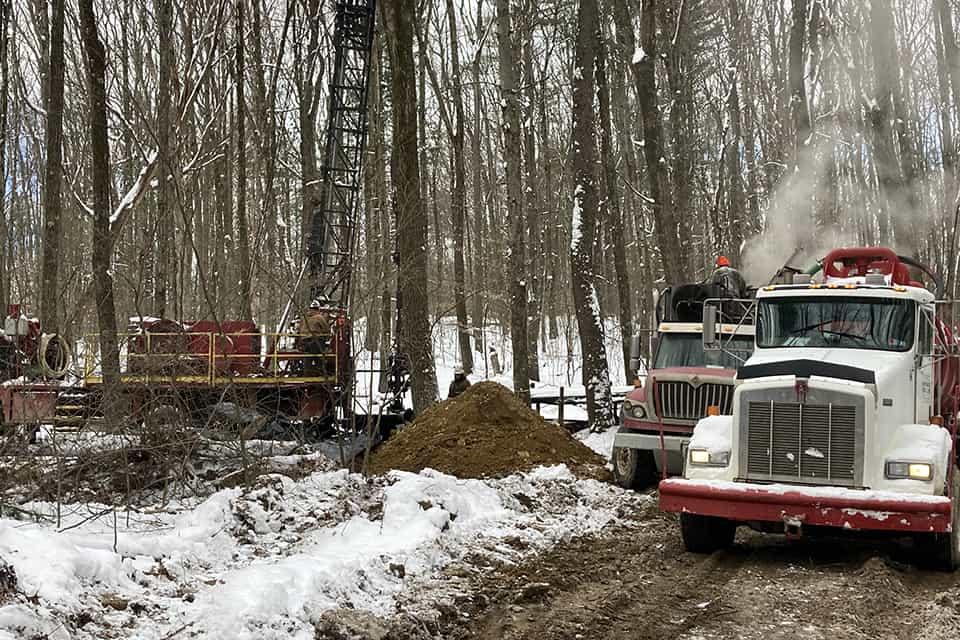
Well plugging work in Cornplanter State Forest in January 2022
Natural Gas Activity Management
DCNR’s Bureau of Forestry currently manages 591 conventional and 999 unconventional natural gas wells located on 83 state forest, six state park, 38 public streambed, seven gas storage, and seven Department of General Services leases.
The Bureau of Forestry holds more than $64 million in plugging and $12 million in performance surety as required by the applicable lease agreements, which is in addition to the surety held by the Department of Environmental Protection.
Within the past year, 22 oil and gas leases were amended to include updated commonwealth terms and conditions; and 17 leases were processed for a change in lessee.
Revenues generated from natural gas resources in 2022 totaled more than $187 million, representing a 56 percent increase over 2021 revenues.
Water Restoration and Protection
Aquatic vegetation suppression occurred at 18 state parks. In coordination with county, federal, and other various entities, the Pennsylvania Class A Noxious Weed hydrilla was suppressed in 412 acres of the Pymatuning Reservoir.
Aquatic vegetation surveys were completed at 1,718 survey points, including complete water area surveys for four impoundments (Shawnee, Pymatuning, Chapman, and Marsh Creek state parks).
Harmful Algal Bloom Monitoring
Twenty parks experienced suspected cyanobacteria bloom conditions and three state parks experienced swimming beach closures to protect public health due to samples that exceeded recreational thresholds for harmful algal blooms.
DCNR continues to collaborate with other agencies on protocols and outreach strategies related to harmful algal blooms.
Forest Pest Management
Spongy Moth (formally known as Gypsy Moth) Suppression -- DCNR conducted a large
Lymantria dispar suppression program, treating more than 209,000 acres of forest in 2022. Egg mass surveys revealed the need to treat a larger area in 2023.
Treatment of Eastern Hemlocks for Hemlock Woolly Adelgid -- Continuing a program that began in 1999, biological control agents were released again to combat
hemlock woolly adelgid. DCNR treated more than 9,458 hemlock trees on more than 1,188 acres of DCNR-managed lands.
Treatment for Emerald Ash Borer -- DCNR staff continued surveys and treatment for
emerald ash borer to conserve and protect ash species across the state. Biological control agents (2,357 parasitoids) were released again, and 78 additional ash trees were treated on DCNR-managed lands.
Chronic Wasting Disease Partnership
DCNR continued participation in the statewide Chronic Wasting Disease Task Force, a multi-agency effort to suppress the spread of chronic wasting disease throughout the state.
The department continued web-based outreach to educate hunters about chronic wasting disease in state forests; and continued to provide locations for bins for depositing deer heads for testing.
Wild Resource Conservation Program
The
Wild Resource Conservation Program received eight grant applications from a variety of applicants, requesting more than $290,000 which were approved for funding by the Wild Resource Conservation Board.
The Wild Resource Conservation Program aids in the conservation of the commonwealth’s flora and non-game fauna.
Now in its fortieth year, the Wild Resource Conservation Program has funded 827 projects totaling approximately $14.3 million.
This includes a diversity of projects including non-game birds, fish, mammals, reptiles, amphibians, plants, fungi, and invertebrates.
The Wild Resource Conservation Program is the only source of state funds to support the study of plant conservation and protection.
Threatened and Endangered Wildlife Species Conservation
DCNR staff continued work with partners to conduct surveys for threatened and endangered species like the Allegheny woodrat and the timber rattlesnake.
Staff worked with partners to protect timber rattlesnakes in Michaux State Forest, a special protection area.
Staff also provided training for loggers regarding practices to minimize disturbance of bats and rattlesnakes.
The Pennsylvania Natural Heritage Program funded and coordinated inventory and monitoring of a variety of threatened and endangered plants, terrestrial invertebrates, mammals, amphibians, and reptiles at 10 high conservation value area sites on state forest land in 2022.
Gallitzin State Forest protected threatened and endangered grassland bird species at the Babcock high conservation value area during their annual two-week stewardship event.
Research and Collection Permits
More than 34 Research and Collection Permits and 20 state forest data requests were issued during 2022.
Research was conducted by 42 universities and numerous public agencies, nonprofit groups, and private citizens.
These projects examine a wide array of topics, habitats, and areas of study each year.
The state forest data requests were provided for various governmental agencies and organizations to further support state forest functions and activities.
Pennsylvania Native Species Day
DCNR joined seven state agencies in June to celebrate Pennsylvania’s first Native Species Day.
A diverse native ecosystem provides a range of benefits to Pennsylvanians, including food sources, timber, climate resilience, outdoor recreation, such as fishing and hiking, and related economies.
Survival of many native species is under increasing pressure from the proliferation of invasive nonnative species that has occurred as global commerce and travel have increased.
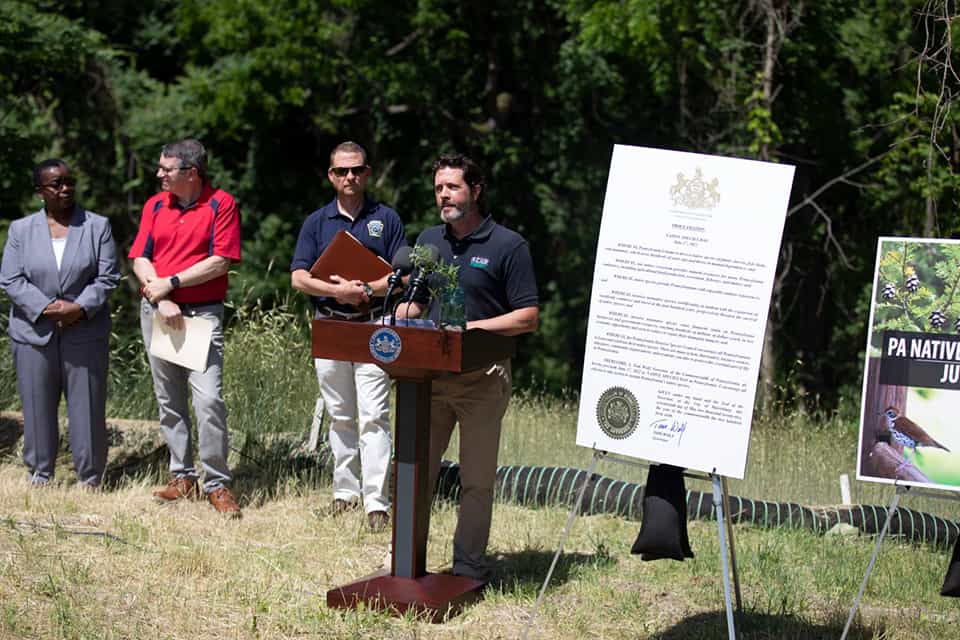
DCNR Assistant State Forester Matt Keefer speaks at Native Species Day event in June 2022